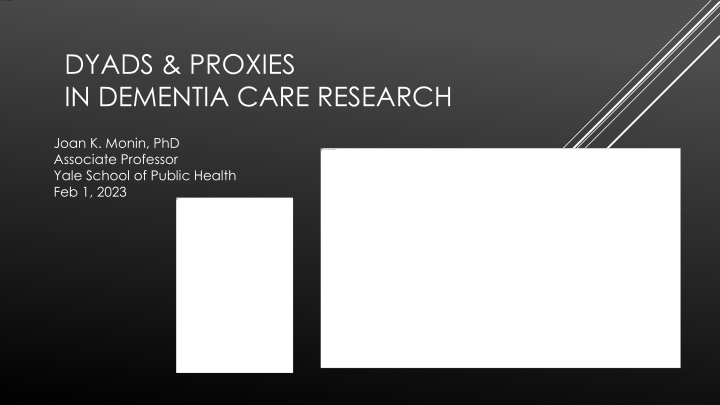
Dyadic Processes in Dementia Care Research
Explore the intricate dynamics between persons living with dementia and their care partners, highlighting the interconnectedness in exposures and outcomes. Delve into the reasons for dyadic data collection, including emotional transmission, social control, and the impact of caregiving stressors on both physical and psychological health.
Download Presentation

Please find below an Image/Link to download the presentation.
The content on the website is provided AS IS for your information and personal use only. It may not be sold, licensed, or shared on other websites without obtaining consent from the author. If you encounter any issues during the download, it is possible that the publisher has removed the file from their server.
You are allowed to download the files provided on this website for personal or commercial use, subject to the condition that they are used lawfully. All files are the property of their respective owners.
The content on the website is provided AS IS for your information and personal use only. It may not be sold, licensed, or shared on other websites without obtaining consent from the author.
E N D
Presentation Transcript
DYADS & PROXIES IN DEMENTIA CARE RESEARCH Joan K. Monin, PhD Associate Professor Yale School of Public Health Feb 1, 2023
OVERVIEW Dyadic processes in dementia caregiving Proxy and dyadic design and analysis Example: The Families Coping Together with Alzheimer s Disease Study (FACT-AD)
Care partner Graces proxy reported QOL of Henry
Henrys own self-reported QOL Grace s own self- reported QOL
REASONS FOR DYADIC DATA COLLECTION The exposures and outcomes of persons living with dementia and care partners are highly interdependent. Share environment, resources, social network connections (Berg & Upchurch, 2007) Linked genetically (e.g., parent/child) or by assortative mating (e.g., romantic partners) (Robinson et al., 2017) Emotional transmission (Monin & Schulz, 2010) Social control (e.g. care partner is in control of the health behaviors of the person living with dementia and vice versa) (Umberson, 1992)
REASONS FOR DYADIC DATA COLLECTION Older adult spouses interpersonal influences over time (Kiecolt-Glazer & Wilson, 2017) Depressive symptoms Frailty Cognitive status Longevity Health behaviors (e.g. sleep, substance abuse, eating) Monthly physical functioning (Precipitating Events Project Study; Monin et al., 2020) Older adults living with dementia and care partners (e.g. Wuttke- Linnemann, et al, 2019; Rippon et al., 2020)
Caregiver stress health models* Caregiving stressors Type and quantity of assistance provided Vigilance demands Time spent caregiving Disease-related stressors Functional Disability Cognitive Impairment Disruptive Behaviors Caregiver psychological and physical health problems *A simplification of models that have dominated the field (e.g. Pearlin, Mullan, Semple & Skaff, 1990). 11
THE THEORY OF DYADIC ILLNESS MANAGEMENT (LYONS, 2018) 12
INTERVENTION EXAMPLE Chair yoga telemedicine intervention on Zoom for PLWD and care partner to do together at home Recruited and administered through adult day service
Acceptability Likert scale ratings of enjoyment of the session each week in poll at the end of the Zoom Adherence # of sessions attended collected based on whether participated or not General health Option 1) Proxy care partner s perception of PLWD Option 2) 3rd party assessment nurse puts in rating for PLWD Option 3) Dyadic self-report from both phone call to each person Time points: Baseline, Weekly during 8-week intervention, 1-month follow-up MEASURES
PROXY OR DYAD? Dyadic? Does your study focus on changing one person s outcome or the outcomes of both members of the dyad? Can both partners self report their own outcomes? Or can both dyad members outcomes be observed by a third party? Proxy? Might there be bias in one or both dyad members self-reports or reports of the other person?
REASONS FOR DYADIC DATA COLLECTION: PROXY REPORTS NOT ALWAYS ACCURATE Monin, J. K., Jorgensen, T. D., & Vroomen, J. L. M. (2020). Self-reports and caregivers proxy reports of unmet needs of persons with dementia: Implications for both partners health-related quality of life. The American Journal of Geriatric Psychiatry, 28(3), 363-367.
PURPOSE OF DYADIC ANALYSIS Dyadic analysis is when you have two individuals in your study with correlated outcome data Romantic partners Mother/child Patient/caregiver Siblings Given the correlated nature of the data, you should not treat them as individuals
LESS THAN IDEAL SOLUTIONS Ignore the correlation Analyze separately Create average couple scores
VARIATIONS OF DYADIC ANALYSIS Types of Dyadic Data Distinguishable vs. Indistinguishable Types of Data Analysis for Dyadic Data Correlations Matched t-tests Repeated measures ANOVA Multi-level models Structural Equation Modeling Log-linear models Cross-sectional and longitudinal
TYPES OF DYADIC VARIABLES Between Dyads Variables that are the same within dyads but differ across dyads Ex: relationship duration, marital status Within Dyads Variables that are different within dyads but the same across dyads Ex: Gender; Role Mixed Dyads Variables differ within and between dyads Ex: Depression, relationship satisfaction The types of variables will guide your approach
PUTTING THE DYAD IN DYADIC ANALYSES Much of the richness of dyadic data is exploring influences one member of a dyad may have on the other To do this we explore: Actor effects Effect of individual s predictor on individual s outcome Ex: influence of my positive affect on my relationship satisfaction Partner effects Influence of a partner s predictor on individual s outcome Ex: influence of my partner s positive affect on my relationship satisfaction Can do this with multilevel modeling
ADRD EXAMPLE: ACTOR PARTNER INTERDEPENDENCE MODEL (KASHY AND KENNY, 1999) Actor PwD perceived support PwD depressive symptoms Partner e Partner e CG perceived support CG depressive symptoms Actor
Pairwise Individual Usually MLM, APIM model Dyad Usually SEM DATA STRUCTURE
Monin, J. K., Doyle, M., Van Ness, P., Schulz, R., Marottoli, R., Birditt, K., Feeney, B. C., & Kershaw, T. (2018). Longitudinal associations between cognitive functioning and depressive symptoms among older adult spouses in the Cardiovascular Health Study. American Journal of Geriatric Psychiatry, 26 (10), 1036- 1046. NOTES. COG= COGNITIVE FUNCTIONING. V5=VISIT 5, V8=VISIT 8, V11=VISIT 11. BOLD LINES ARE SIGNIFICANT P<.05. SUPERSCRIPT INDICATE CONSTRAINED PATHS.
There was a significant gender effect on the interaction of the lagged disability of both actor and partner ( 07= 0.01, SE = 0.003, p = .04). Wives with higher disability experienced stronger partner effects than wives with lower disability. The influence of partner effects on husbands did not differ by disability level.
FAMILIES COPING TOGETHER WITH ALZHEIMER S DISEASE (FACT-AD) STUDY Focus on adult children and their parent with early stage AD/ADRD Informed by attachment theory basic research (mutual support behaviors and early life parent/child experiences) is needed to inform and adapt existing interventions in other populations (e.g. Circle of Security) Stage 0 dyadic, longitudinal, and observational study of 200 dyads.
ORIGINAL (FACT-AD) STUDY PROCEDURES Both dyad members interviewed separately and then come together for videotaped discussions about current and future stressors (2 weeks after interviews) at baseline and a one-year follow-up. All variables measured with existing validated self-report scales. Support behaviors measured with an observational coding system created by Co-I Feeney. Blood pressure continuously measured during discussions/activities in the lab. Study opened for enrollment August 2019. Year one data is collected. Finishing the one year follow ups.
FAMILIES COPING TOGETHER WITH ALZHEIMER S DISEASE (FACT-AD) STUDY Recruitment Methods
RECRUITING DYADS Definition of person living with early-stage dementia Definition of care partner Outreach to both groups separately and together Assessing eligibility criteria
METHODS Supporting both individuals autonomy during the information and consent process Completing interviews separately and privately to minimize interpersonal influences Capture interpersonal influences with observed interactions (e.g. discussion, activities)
TAKE HOME MESSAGES FOR DYADIC RESEARCH IN AD/ADRD CAREGIVING Consider more than just the person living with dementia in your research Think about how you want to capture dyadic influences and plan your design and analysis accordingly Carefully consider your methods/measures to minimize interpersonal bias and also to learn about interpersonal influences.
CHALLENGES AND FUTURE GOALS FOR AD/ADRD CAREGIVING EMBEDDED PRAGMATIC CLINICAL TRIALS Stage of dementia limits self-report We want to minimize participant burden (e.g. keeping the survey short for persons living with dementia; prioritizing pragmatic) Multiple and changing care partners Very limited information in the health care system about families or ways to link data for households Dyadic data and APIM and multilevel models not always needed (e.g. just capturing any caregiver information in the health care system would be a major advance!)
DEMENTIA PEER COALITION AND EMPOWERING PARTNERSHIPS (LIVEWELL)
The Social Gerontology and Health Lab National Institute on Aging F32 AG031635; K01 AG042450-01; P50 AG05133, AG015321, AG026010; R21AG055861-01A1; R01AG058565 Yale s Claude D. Pepper Center (NIA) P30 AG21342 Member of the Design and Statistics Core of the U54AG063546 Imbedded Pragmatic AD/ADRD Clinical Trials (IMPACT) Collaboratory: Transforming Dementia Care 38





















